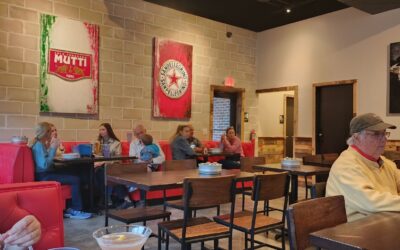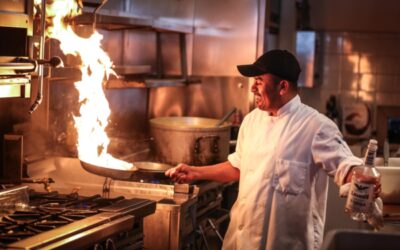What FOH and BOH Mean in a Restaurant
What is FOH and BOH?
FOH and BOH are abbreviations that describe the two different parts of the restaurant. FOH stands for Front of the House, and includes everything guests see like the dining areas and bar. So, what does BOH mean? BOH stands for Back of the House and includes the kitchen, the line, manager’s offices and basically everything guests do not see.
The Difference Between FOH and BOH and Why They Matter?
FOH and BOH hold a restaurant together. The “FOH” known as the Front of the House is all areas within your establishment that customers have a direct experience with. Examples of FOH include:
- Entryway
- Parking lot
- Waiting Area
- Bar
- Dining Room
- Restrooms
FOH Cleanliness and the Impact on Customer Satisfaction
In the same vein, the presentation, cleanliness, staff, and overall management are important. Yummy food and a clean establishment will guarantee customer satisfaction. Additionally, not enough parking is another reason people choose another establishment. Lastly, nobody wants to be left with the responsibility of cleaning up after others. The spic-and-span of your restroom says a great deal about your restaurant. By providing a clean and inviting space, you are supporting the retention of customers, resulting in revenue.
It’s Not Just About The Food
Today, customers consider more than just the quality of food and friendly staff. In addition to yummy food, customers consider the overall cleanliness. Barber & Scarcelli, 2009 examined customer perceptions of restaurant restroom cleanliness and their impact on sales. Here’s what they found: “cleanliness is highly valued in our society and has a direct influence on our positive attitude towards public spaces such as restaurants.” In a study by Blackiston and Evans (2004), says seventy-eight percent of consumers suggested a clean restroom also meant a clean kitchen.
The Overall Cleanliness in the FOH and BOH Matter in a Restaurant
Do you want a positive review? The interior and exterior matter. Many factors influence the restaurant patrons’ perceptions of service quality (Abdelhamied, 2011;Barber, Goodman, & Goh, 2011;Barber & Scarcelli, 2009 Ryu & Jang, 2008;Stevens et al., 1995). So, there you have it. The cleanliness of your restroom at your establishment says a lot about you and your business, it’s also how you present the FOH that can also inadvertently allow your customers to judge your BOH.
Importance of Professional and Clean Staff

Another FOH to keep a watchful and purposeful eye on is your staff and their appearance. Team members who work in your establishment should be clean, well-dressed, have a professional demeanor, and be exceptionally accommodating at all times. Customer-facing positions need to be able to carry themselves professionally.
The host/hostess, bartender, server, food runner, busser, bar-back, sommelier, headwaiter/waitress, general manager, and FOH manager are all integral in providing a fine-dining experience.
A solid team will provide support and returning customers will give your restaurant a five-star rating. The ability to keep these multiple facets in good, working order will make your restaurant one everyone loves and returns to. You don’t want a bad rap for being dirty and poorly staffed.
Is your Hostess Station Visible and Friendly?
Customers want delicious food, a comfortable and inviting restaurant, along with friendly staff. Are you noticing that even with a “please wait to be seated sign” your guests seem to be seating themselves? Stop blaming your guests for taking initiative. For that reason, start placing emphasis on the positioning and visibility of your hostess station. Can it be seen easily upon entering the entryway? Is it labeled so that guest know to wait there for a hostess? Is your hostess able to greet them promptly? And, is the area where guest have to wait comfortable enough if they need to wait?
First Impressions Are Everything
First impressions are truly everything in the restaurant industry. Make your welcome area comfortable and clean. Your hostess should be welcoming and greet guests appropriately, and try, as hard as it is, to not keep guests waiting for too long. Guests should not have to wait more than a minute or two to be acknowledged. To conclude, it shouldn’t take more than 3 to 4 minutes for a server to acknowledge you. Now, this number varies based upon the type of establishment you are at. For that reason, here’s a friendly reminder: during busier times, the restaurant is just that, busier.

Bar
Everybody enjoys a friendly and fun bar. If you have a bar at your restaurant, aim to make it inviting. Allow it to flow nicely into the main dining area and serve its purpose as an alternative place to dine if the main floor is full. The bar area is where you’ll want to provide entertainment in the form of large flat-screen televisions.
Keep the bar area exceptionally clean. Set a high standard of cleanliness. Customers can see everything behind the bar. You want to be able to serve guests quickly. One way of maintaining that line of efficiency is by organizing everything near, around, and behind the bar. Use proper liquor pourers to prevent pesky fruit flies. Shoo fly, don’t bother me.
Dining Room
The heart and soul of your restaurant is the main dining room. This is where your customers wine, dine, chat, laugh, and EAT. Hence why this is where the majority of the customers time is spent. You want to keep this area clean and you want to make sure the layout of the space flows nicely from room-to-room and that your staff is able to maneuver well. Customers should be able to access their seats and exit the dining room comfortably.
Outdoor Seating
Adding outdoor seating increases the capacity and dining revenue. In the summer months, and if it’s nice, guest prefer to dine at restaurants with decks and patios. Outdoor seating options add great value. For example, canopies and umbrellas for guest are great in case that unpredictable weather rolls in. You want to protect your guest from the hot sun.
Front of House Positions – Staff Spotlight

FOH employees directly interact with guests and the kitchen, and inevitably have many job functions.
- General Manager – The GM is the drone of the restaurant staff including the front and back of house. The majority of their time is spent in the dining room. This position is pivotal to the owner of the restaurant. A good GM means the world of difference. The restaurant owner relies on the GM to be their eyes and ears and ensure all operations run smoothly.
- Front of House Manager – This position reports to the GM and oversees all employees who work in the front of house. They interview and hire new staff #Fliptable, make schedules, and handle customer complaints.
- Headwaiter – The headwaiter leads the wait staff, host staff, and bussers in providing the best customer experience possible. A good headwaiter has a positive attitude and a doer mindset. Most importantly, they act as a supervisor in addition to serving their own tables.
- Bartender – The bartender is who your customers trust to make them their perfect drink for any occasion. They pour beer, wine, create mixed drinks, and serve soft drinks. Their additional duties include serving food and prepping bar garnishes like lemon and lime slices before the shift.
- Server – Servers are your people-people. Therefore, servers should be personable and accommodating because they have the most direct interaction with guests. A good server memorizes the menu, answers questions, takes customer orders, make suggestions, and interacts with kitchen staff. For that reason, a good server is also professional and well-mannered.
- Food Runner – Nobody likes being served cold food. Provide a valuable service and make sure food is served immediately and served hot. Interact with guests. Know what’s on the menu and be able to meet any additional requests, like extra ranch, silverware, napkins, or drink refills.
- Bar-Back – Bar-backs are the assistant to the bartender.
- Busser – These staff members prepare tables for guests to be seated and clear away dirty dishes. Bussers should have clean apparel, aprons, and professional attitude as most of their time is spent in the dining area.
Quality Staff Over Quantity
Most noteworthy, quality and attentive staff will support the retention of customers. You should aim for the most delectable food items and the cleanest restaurant. If your staff is not clean, welcoming, accommodating, and organized, it will be reflected in your sales and overall rating. Therefore, you should make it a point to provide quality staff both at the FOH and BOH in a restaurant.
The Heart of the Restaurant:
In conclusion, the FOH and BOH in a restaurant are equally important. BOH is the heart of the restaurant for many reasons. Behind the scenes work is happening. Chefs cook, employees talk among themselves, and inventory is kept. Employees are pumping out order after order to maintain satisfied customers and keep the restaurant running smoothly and efficiently.
What Are the Common BOH Areas?
BOH or “back of house” is typically the designated areas in the restaurant the customers don’t see or interact with. Some examples of BOH would be:
Kitchen– The largest and most important part of the BOH is the kitchen. Home to the executive chef, sous chef, line cooks and dishwashers. The most chaotic part of the BOH and organization is a key component to maintaining an efficient kitchen atmosphere.
Offices– You won’t find many staff members in this area due to the confidentiality. This area is used for creating the menu, interviewing, scheduling etc. The back office is home to the restaurant management staff
Storage Space– This area houses administrative files. Keep this space organized at all times.
Break Room- Growing in popularity out of knowing the importance of healthy staff breaks, this is a place for employees to relax, eat lunch, talk etc.
The Back of House Positions
- Kitchen Manager – The kitchen manager is the person in charge of managing the back of house staff. Their duties include making sure safety is up to par, hiring new employees, and controlling the chaos by helping out wherever needed.
- Executive Chef/Head Chef – The executive chef is the most senior member of the kitchen. They create menus and specials, order food needed, determine expenses, and do administrative work.
- Sous Chef – The sous chef reports directly to the executive chef. They supervise the kitchen staff, train employees and make the schedule. If the head chef is absent, the sous chef is in control.
- Line Cook – Stationed in the kitchen and are divided up by type of food cooked or position in the kitchen. Examples could be fry cook or salad cook.
- Expeditor – The expeditor is in charge of orders and organizing them. They are typically very familiar with the menu items.
- Dishwasher – There are usually multiple dishwashers and they’re in charge of washing and drying dishes and glassware.
The Goals of FOH and BOH in a Restaurant
Teamwork in the FOH and BOH ensures profit and satisfaction. The FOH and BOH should stay in communication and work as a team daily Ultimately, the restaurant’s goal is to satisfy the customer and create an experience worth repeating. It’s all about organization. No mess, no stress. Food needs to be prepared in a timely manner. The servers and management need be friendly and interactive.




A excellent way to define and explain the different teams and jobs in a restaurant. Simple, easy and great examples. Excellent! Thank you!
Thank you, Ali. We are always striving to release positive and current content. Subscribe to our Tip Jar Blog and never miss content delivered right to your email. Cheers.
Comments are closed.